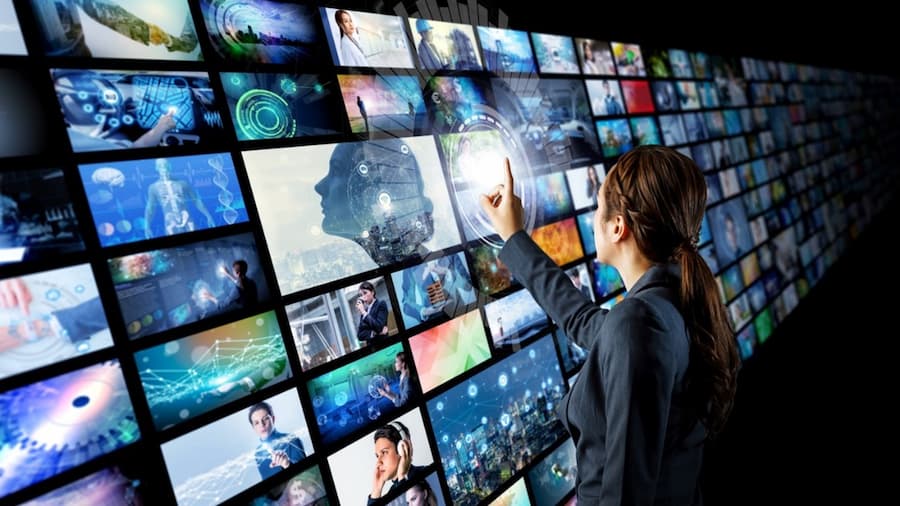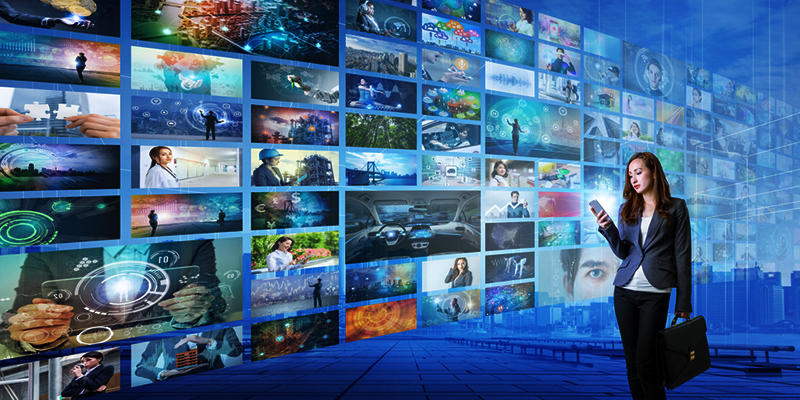In the rapidly evolving landscape of technology, the convergence of television and interactive features represents a pivotal shift in how we consume media. Interactive television (iTV) is poised to revolutionize the viewing experience, integrating elements that allow users to engage with content in dynamic and immersive ways. This transformation is fueled by advancements in mobile technology, artificial intelligence (AI), augmented reality (AR), and the internet of things (IoT). This article delves into the future of interactive television, exploring its potential, the technology driving it, and the impact on both consumers and the entertainment industry.
1. The Evolution of Television: A Brief Overview
Television has undergone significant transformations since its inception. From the bulky black-and-white cathode-ray tube (CRT) sets to sleek, ultra-high-definition (UHD) smart TVs, each technological leap has enhanced the viewing experience. The advent of color TV, cable and satellite broadcasting, and digital TV were milestones that broadened access to diverse content and improved picture quality.
The introduction of smart TVs marked the beginning of the interactive era, enabling internet connectivity and access to streaming services. However, the future promises even more sophisticated levels of interaction, integrating voice control, gesture recognition, personalized content, and real-time engagement.
2. Key Technologies Driving Interactive Television
Several cutting-edge technologies are shaping the future of interactive television, transforming passive viewers into active participants.
2.1. Artificial Intelligence and Machine Learning
AI and machine learning (ML) are at the core of interactive television, enabling personalized content recommendations, voice recognition, and intelligent interfaces. AI algorithms analyze viewing habits, preferences, and behaviors to curate tailored content, enhancing user engagement. Additionally, AI-powered virtual assistants, like Amazon’s Alexa and Google Assistant, facilitate voice-controlled navigation and search, making interactions more intuitive.
2.2. Augmented Reality and Virtual Reality
AR and VR technologies are set to revolutionize the way we experience television. AR overlays digital information onto the physical world, enhancing live broadcasts with interactive elements such as real-time statistics during sports events or additional information during documentaries. VR, on the other hand, offers immersive experiences, transporting viewers into a virtual environment where they can interact with the content. For example, VR can provide a 360-degree view of a concert, allowing users to feel as if they are part of the audience.
2.3. Internet of Things (IoT)
The IoT ecosystem connects various smart devices, creating a seamless and integrated viewing experience. Smart TVs can communicate with other IoT devices, such as smart speakers, lighting systems, and home security cameras, to create a synchronized and immersive environment. For instance, the lights in a room can dim automatically when a movie starts, or the TV can display a live feed from a doorbell camera when someone rings the bell.
2.4. 5G Connectivity
The rollout of 5G networks is set to enhance the capabilities of interactive television by providing faster and more reliable internet connections. With higher bandwidth and lower latency, 5G will enable seamless streaming of high-definition content, real-time interactions, and a more robust connection between IoT devices. This will pave the way for more sophisticated interactive features, such as multi-angle live sports broadcasts and real-time multiplayer gaming.
3. Features of Future Interactive Television
The future of interactive television promises a plethora of features that will redefine how we engage with content.
3.1. Personalized Content and Recommendations
As AI algorithms become more sophisticated, the ability to deliver highly personalized content will improve. Future interactive TVs will not only recommend shows and movies based on viewing history but also adapt to the viewer’s mood, time of day, and even their social interactions. For example, if a user frequently watches cooking shows, the TV might suggest related recipes or nearby restaurants offering similar dishes.
3.2. Enhanced Social Interaction
Interactive television will integrate social media platforms, allowing viewers to share their experiences and opinions in real-time. Features such as live chats, social media integration, and synchronized viewing parties will make it easier for users to connect with friends and other fans while watching their favorite shows. Additionally, viewers can participate in live polls, trivia games, and other interactive elements, enhancing the communal aspect of TV watching.
3.3. Voice and Gesture Control
The future of interactive television will see a significant reduction in the need for traditional remote controls. Voice and gesture control will become more prevalent, allowing users to navigate menus, search for content, and adjust settings with simple voice commands or hand movements. This will make the interaction more intuitive and accessible, especially for those with mobility impairments.
3.4. Interactive Advertising
Advertising will become more engaging and less intrusive with interactive television. Brands can create interactive ads that allow viewers to explore products in detail, make purchases directly from the TV, or even customize products. For example, an ad for a new car might let viewers virtually explore the vehicle’s interior, change its color, and book a test drive, all from the comfort of their living room.
3.5. Interactive Storytelling
Interactive storytelling will transform the way we consume narratives. Viewers will have the ability to influence the plot of movies and TV shows by making choices for the characters. This choose-your-own-adventure style of storytelling will create a more engaging and immersive experience, allowing viewers to feel more connected to the content.
4. Impact on the Entertainment Industry
The advent of interactive television will have a profound impact on the entertainment industry, affecting content creation, distribution, and monetization.
4.1. Content Creation
Content creators will need to adapt to the new possibilities offered by interactive television. This will involve developing new formats and storytelling techniques that leverage interactive features. For instance, filmmakers and TV producers might create multiple plotlines and endings, or integrate real-time audience participation into live broadcasts. This shift will require a more collaborative approach to content creation, involving writers, developers, and audience feedback.
4.2. Distribution and Monetization
Interactive television will also change the way content is distributed and monetized. Streaming platforms and broadcasters will need to invest in the necessary infrastructure to support interactive features, such as AI-driven recommendation systems and real-time data analytics. Additionally, new revenue models will emerge, such as pay-per-interaction, where viewers are charged for participating in interactive elements, or subscription tiers that offer exclusive interactive content.
4.3. Viewer Analytics
The ability to track viewer interactions in real-time will provide valuable insights for content creators and advertisers. Detailed analytics on how viewers engage with content, which choices they make, and how they interact with ads will help tailor future offerings to better meet audience preferences. This data-driven approach will enable more targeted and effective marketing strategies, benefiting both consumers and businesses.
5. Challenges and Considerations
While the future of interactive television holds immense potential, there are several challenges and considerations to address.

5.1. Privacy Concerns
The increased level of interactivity and data collection raises significant privacy concerns. Ensuring that user data is collected, stored, and used responsibly will be crucial. Transparent data policies, robust security measures, and giving users control over their data will be essential to build trust and protect privacy.
5.2. Accessibility
Ensuring that interactive television is accessible to all users, including those with disabilities, is a key consideration. Voice and gesture control, as well as customizable interfaces, can enhance accessibility, but developers must prioritize inclusivity in their designs.
5.3. Technological Adoption
The success of interactive television will depend on the widespread adoption of the necessary technologies, such as AI, AR/VR, IoT, and 5G. This will require significant investment from manufacturers, broadcasters, and service providers, as well as a willingness from consumers to adopt new devices and platforms.
5.4. Content Standardization
Creating standardized formats and protocols for interactive content will be important to ensure compatibility across different devices and platforms. Industry collaboration and the development of common standards will help streamline content creation and distribution, benefiting both creators and viewers.
6. Case Studies and Examples
To illustrate the potential of interactive television, let’s explore some real-world examples and case studies.
6.1. Netflix’s Interactive Content
Netflix has been a pioneer in interactive storytelling, with titles like “Black Mirror: Bandersnatch” and “You vs. Wild.” These interactive shows allow viewers to make choices that influence the plot, creating a unique viewing experience. The success of these experiments demonstrates the potential for interactive content and the audience’s appetite for new forms of storytelling.
6.2. Samsung’s Smart TV Innovations
Samsung has been at the forefront of integrating AI and IoT into their smart TVs. Features like Bixby voice control, SmartThings integration, and AI-driven content recommendations showcase the possibilities of interactive television. Samsung’s continuous innovation in this space highlights the industry’s commitment to enhancing the viewing experience.
6.3. Augmented Reality Sports Broadcasts
AR technology has been used to enhance sports broadcasts, providing real-time statistics, player information, and interactive replays. For example, during the 2020 Tokyo Olympics, broadcasters used AR to display athlete data and event information in real-time, enriching the viewing experience and providing deeper insights for fans.
7. Conclusion
The future of interactive television is incredibly promising, driven by advancements in AI, AR/VR, IoT, and 5G connectivity. As these technologies continue to evolve, they will transform the way we consume media, making it more personalized, immersive, and engaging. The integration of interactive features will not only enhance the viewing experience but also reshape the entertainment industry, offering new opportunities for content creators, distributors, and advertisers.
However, to realize the full potential of interactive television, it is essential to address challenges related to privacy, accessibility, technological adoption, and content standardization. By prioritizing these considerations, the industry can create a future where television is not



